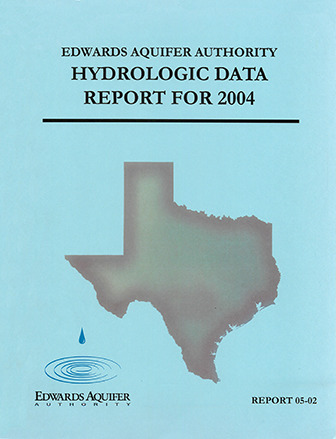Edwards Aquifer Authority Hydrologic Data Report for 2004

| Author | Hamilton M, Johnson S, Hoyt JR, Esquilin R, Thompson EL, Luevano G, Gregory D, Burgoon C, Mireles J, Gloyd R, Sterzenback J, Mendoza R, and Schindel GM |
| Year | 2005 |
| Description | Annual report for 2004 on recharge, discharge, water levels and water quality in the Edwards Aquifer San Antonio Region |
| Report Number | 05-02 |
| Publisher | Edwards Aquifer Authority |
| Location | Edwards Aquifer - San Antonio Area |
| Cover | View Download |
| File | View Download |
| Summary |
|
(Excerpted from the report Summary) Water levels remained above the historical mean value at the Bexar County (J-17) index well throughout 2004. Other wells in the region exhibited similar behavior. … Bexar County index well (J-17) reached the second highest water level on record, while monitoring wells in Comal and Hays counties achieved new record highs in 2004. … Precipitation in the Edwards Aquifer region was above mean in 2004, with rainfall amounts ranging from approximately 15 percent above mean in Uvalde County to over 50 percent above mean in Medina, Comal, and Hays counties. … Total recharge to the Edwards Aquifer was 2,176,100 acre-feet in 2004, approximately 388 percent above the median of 560,900 acre-feet for the period of record (1934-2004). Calendar year 2004 is the second highest annual recharge on record. … In calendar year 2004, groundwater discharge from the Edwards Aquifer through wells and springs totaled 937,324 acre-feet. This amount is approximately 38 percent above the median of 679,500 acre-feet for the period of record (1934-2004). … For samples collected in 2004, nitrate-nitrite as nitrogen concentrations ranged from below the laboratory reporting limit to 8.78 mg/L in samples from wells, streams, and springs in the Edwards Aquifer region…. One VOC was detected at or above its associated MCL in two wells. The compound tetrachloroethene (PCE) was detected at 20 μg/L in Bexar County well AY-68-36-601RS, and at 5 μg/L in Uvalde County well YP-69-51-114. The MCL for PCE is 5 μg/L. Additional detections of PCE occurred in five well samples from Bexar County ranging in concentration from 0.02(J, TB) μg/L to 0.8(J) μg/L. …One additional SVOC, naphthalene, was detected in a spring sample at 1(J) μg/L. …The data flag (J) combined with the other issues relative to these compounds indicates a low probability of contamination issues related to the listed compounds. In 2004, samples from 23 wells and five spring groups were analyzed for herbicides, pesticides, and PCBs. None of the well samples tested positive for these compounds. …No herbicides or PCBs were detected in the spring samples. Pesticide detections in spring samples are …Gamma Chlordane…Alpha BHC… Gamma BHC…Delta BHC …Heptachlor… Edwards Aquifer water is generally of such high quality that it normally requires only chlorination to meet public drinking water standards. However, the detection of nitrates and trace quantities of metals and organic compounds in the aquifer is a concern and the Authority will continue to monitor for these compounds to determine possible sources and trends. Nitrate as nitrogen was detected frequently with the highest concentrations detected in well water samples. Quantification of many of the metals and organic compounds at the low concentrations indicated in the report can be problematic and continued monitoring will be required to confirm their presence or absence. However, the confirmed detections of organic compounds such as PCE in Uvalde and Bexar counties is a concern, and warrants additional monitoring in the future. The Authority’s aquifer-wide water quality sampling program will continue to monitor wells, streams, and springs for indications of water quality impacts. Authority staff and cooperating agencies will continue to analyze any anomalous data and investigate possible sources of contamination. |
Search for Documents
Advance Search
Explore EAA's Scientific Reports
- All Reports
- Groundwater Recharge, Recharge Zone
- Groundwater Movement
- Geomorphology and Caves
- Weather Modification
- Geology
- Water Use and Conservation
- Geochemistry
- Water Resources Planning and Management
- Floods and Drought
- Water Quality
- Climatology
- Surface Water / Groundwater Relationship
- Biology
- Springs, Groundwater Discharge
- Archaeology
- RZ Protection
- Aquifer Levels
- Remote Sensing
- Precipitation
- Overview Studies
- Modeling
- Hydrology and Hydrogeology
- History
